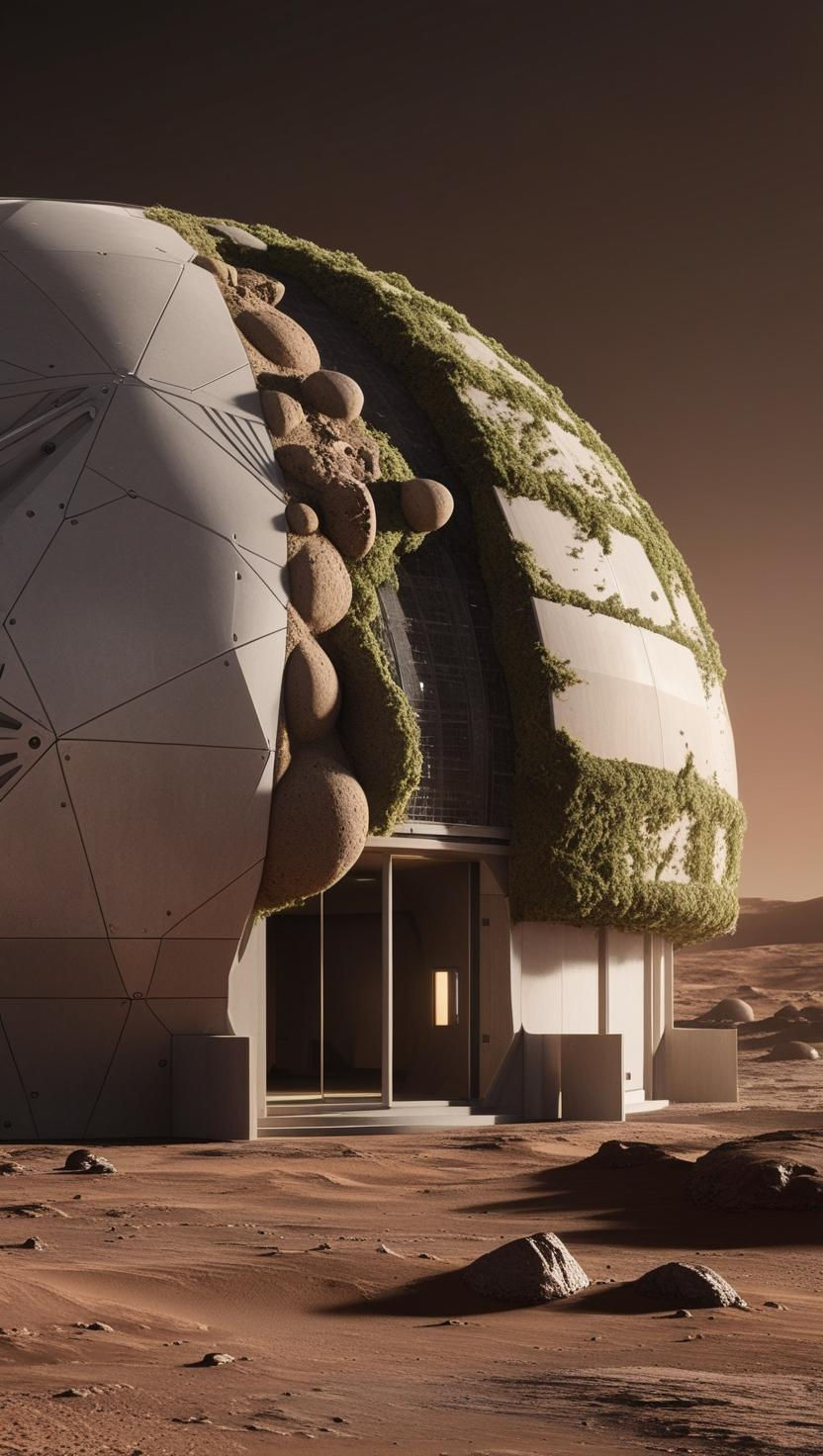
scroll down

01
Sustainable Mars Colonization
Building a New World from the Ground Up
A fully self-sustaining Mars colony must operate independently of Earth. By leveraging In-situ Resource Utilization (ISRU), we can extract and refine Martian materials to build infrastructure, generate energy, and sustain human life. Every resource on Mars must be optimized for long-term survival.



02
Energy & Infrastructure for a New World
Powering Mars, Transforming the Future
Establishing a permanent Mars colony requires innovative infrastructure and energy solutions. Paraterraforming—creating habitable microenvironments—enables sustainable living. Utilizing local materials and renewable energy sources ensures a resilient, self-sufficient settlement.



03
The Path to a Thriving Martian Society
Mars Tech, Earth Gains
Paraterraforming and In-situ Resource Utilization will drive advancements in sustainable habitats, high-purity manufacturing, and energy innovation. Mars-based industries could yield $100+ billion annually from rare materials, zero-gravity production, and new technologies. Investing in Mars is investing in Earth's future.





<<< <<< <<< <<<
Essential for water, oxygen, and fuel production.
Best locations: Arcadia Planitia,
Utopia Planitia,
or the poles.

Near Ice Deposits


<<< <<< <<< <<<
Natural protection against radiation and temperature fluctuations.
Best locations:
sites in Tharsis
region

Lava Tubes & Caves


<<< <<< <<< <<<
More sunlight for solar power and milder temperatures.
Best locations:
Terra Meridiani,
Elysium Planitia,
Amazonis Planitia

Equatorial Regions

location selection
3 types of colonies will be built where resources are most accessible.
hover
AGRICULTURE
martian food production
scroll down
martian agriculture
hydroponic farming

On Mars, hydroponic farming cultivates plants without soil, suspending roots in nutrient-rich water solutions within climate-controlled, pressurized domes to overcome the planet's toxic atmosphere and scarce liquid water, enabling sustainable food production for colonies.

aeroponic farming

On Mars, aeroponic farming grows plants with their roots suspended in air, nourished by a fine nutrient mist inside sealed, climate-controlled chambers, maximizing water efficiency and oxygen production while thriving in the planet’s harsh, low-gravity environment.
lava tube farming

Fast-growing wheat thrives in a pressurized lava tube dome on Mars, its accelerated growth cycle fueled by tailored LED light spectra, enriched CO₂, and hydroponic nutrients, providing a reliable staple crop for the colony’s bread and beyond.
cockroach farming
_.jpg)
Radiation-resistant cockroach farms flourish in Mars' pressurized lava tubes, their genetically enhanced strains consuming organic waste and exhaling trace oxygen while producing dense protein biomass—transforming them into the red planet's perfect closed-loop life support system: protein-rich food, healing medicine, waste processors, and emergency radiation shields in one resilient package.
MANURFACTURING
martian TRANSPORTATION
SCROLL + HOVER
martian TECHNOLOGY

Biomanufacturing
Using Martian microbes or engineered organisms:
-
Biopolymers
-
Bio-ores
-
Biocement

Self-Replicating Machines
Developing machines that can autonomously build copies of themselves:
-
Initial seed factory from Earth
-
Resource gathering and replication
-
Diverse product manufacturing

Ceramics and Composites
Going beyond regolith bricks:
-
High-temperature ceramics
-
Radiation-shielding composites
-
Self-healing composites

Atmospheric Resource
Refining
Employing plasma or electrochemical processes to extract and refine valuable elements directly from the Martian atmosphere.

Subterranean Manufacturing Hubs
Establishing geothermal energy manufacturing facilities within lava tubes for radiation protection and temperature stability.

Directed Energy Material Synthesis
Utilizing focused energy beams (lasers, microwaves, particle beams) to precisely manipulate and combine Martian resources into novel materials.
TRANSPORTATION
martian TRANSPORTATION
SCROLL + HOVER
martian TECHNOLOGY


exogate
Exogates will offer instantaneous travel across vast distances, bridging Mars and Earth in the blink of an eye.


zpe-saucers
Harnessing the very fabric of reality, zero-point energy saucers will offer frictionless, high-speed travel both on Mars and between planets.


hyperloop pods
Hyperloop technology, adapted for the Martian environment, will offer radiation-free underground transportation for both personnel and cargo.


hover vehicles
Automated rovers and transports, powered by the quantum vacuum, will be capable of exploring vast distances with minimal resource consumption.

speed - terraforming
Engineered Extremophiles
Developing extremophile organisms (bacteria, algae) specifically engineered to thrive in the target planet's conditions and rapidly convert atmospheric gases or detoxify the soil. This requires advanced genetic engineering and synthetic biology.
Artificial Photosynthesis
Creating artificial systems that mimic photosynthesis but are far more efficient. These systems could directly convert atmospheric CO2 into oxygen and other useful gases at a much faster rate than natural processes.

Nanotechnology
Deploying nanobots to perform tasks like soil detoxification, atmospheric processing, or even building infrastructure allows for targeted manipulation of planetary systems at a molecular level.
Directed Energy Processing
Utilizing powerful directed energy beams (lasers, microwaves) to selectively break down or combine atmospheric molecules, or to rapidly heat and process soil, could enable large-scale atmospheric and geological transformations.
speed - terraforming
.png)
All space exploration missions utilize the Exo-Gate, a quantum portal enabling interplanetary transit within our solar system.

2030
Robotic Precursors & Resource Mapping
*FOCUS*: Deploying advanced robotic systems for detailed resource mapping, initial site selection, and establishing communication networks. *TECHNOLOGY*: AI-driven rovers, drones, advanced 3D printing for initial habitat and infrastructure prototypes.
2040
Engineered Biomes &
Initial Water Redistribution
*FOCUS*: Establishing enclosed engineered biomes for accelerated oxygen production and deploying systems for accessing and redistributing subsurface water. *TECHNOLOGY*: Large-scale artificial photosynthesis systems, engineered algae/fungi, advanced geomantic drilling and pumping systems for water redistribution.
2035
initial Habitat Construction &
ISRU Demonstration
*FOCUS*: Establishing initial human-tended research bases and demonstrating in-situ resource utilization (ISRU) technologies for water extraction and construction materials. *TECHNOLOGY*: Modular habitat construction, advanced drilling and mining equipment, initial life support systems.
Automated Atmospheric & Soil Preparation Systems Deployment
*FOCUS*: Deploying large-scale automated systems for atmospheric processing (CO2 conversion) and soil remediation, utilizing nanobots and directed energy. *TECHNOLOGY*: Nanobot swarms, directed energy systems for atmospheric and soil manipulation, initial deployment of engineered extremophiles for soil preparation.
2050
Expanding Terraforming &
Initial Open-Air Habitats
*FOCUS*: Gradual expansion of terraforming efforts, including controlled water redistribution, atmospheric management, and the construction of initial open-air habitats in localized, controlled environments. *TECHNOLOGY*: Advanced atmospheric management systems, localized geomagnetic induction, development of self-sustaining ecosystems.
© www.d-m-x.space. All rights reserved.




